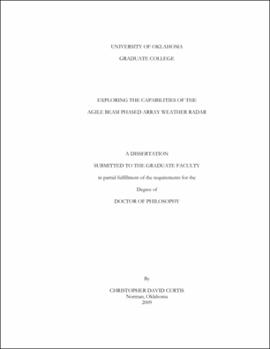| dc.description.abstract | Weather radar researchers have long been eager to exploit the capabilities of phased array antennas, but high cost and technical complexity have postponed their widespread use in radar meteorology. With the aging of the current network of operational Doppler weather radars, the possibility of replacing them with phased array radars has renewed interest in applying this technology to weather radar research. The main focus of this research is the "agile beam" or electronic scanning capability of phased array antennas. Three research areas that take advantage of this agile beam capability are addressed in this work: spectral characterization of ground clutter with phased array radar data, staggered PRT beam multiplexing (SBMX), and rapid weather detection. Most of the research on ground clutter filtering has been applied to rotating antennas, but the agile beam capability of the phased array allows the collection of data with a stationary antenna. Studying the characteristics of ground clutter spectra for a stationary antenna could lead to new techniques and improvements for clutter filtering with phased arrays. Ground clutter data were collected under varying wind conditions, foliage levels, and terrain types. The shapes of the ground clutter spectra are then characterized using a novel quadratic clutter model, and the dependence of the model parameters on different conditions is explored. The model is then applied to the examination of clutter width and the time series simulation of ground clutter. SBMX takes advantage of the ability of the phased array to scan the beam in a different direction on a pulse-to-pulse basis which can save time by collecting samples that are nearly independent. SBMX is compared to two conventional scanning strategies to assess its performance using both simulations and real data. It performs well at high signal-to-noise ratios and narrow spectrum widths, but the staggered PRT strategy performs comparably to SBMX, takes less time, and has proven strategies for clutter filtering. The last area of research, rapid weather detection, looks at the use of beam multiplexing to improve the detection of weather signatures. A simple beam multiplexing strategy outperforms a contiguous pulse strategy because the probability of detection of weather signatures is constant for beam multiplexing while the probability of detection for contiguous pulses decreases at narrow spectrum widths. The effects of beam broadening on the scanning strategies are also examined. | |
